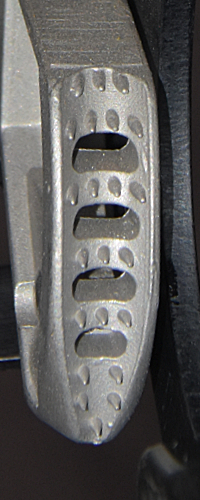Technical Details
I acquired this pair of ascenders new from Jeffrey Neff in
2005. I acquired another pair in 2017 as part of Bob Thrun’s collection.
 The shell is a tall irregular shaped stamping made from 4 mm.
aluminum alloy sheet metal. A bend forms a rope channel in the
upper portion of one side and a smaller cam channel lies opposite
the first. A hole drilled through both sides of the cam channel
accepts a 5 mm. semi-tubular rivet that supports the cam and cam spring.
The round head of the rivet lies in front, while the roll is exposed
on the rear. The handle below the cam has a soft black plastic
hand grip molded into place. The hand grip has four finger grooves.
A 16.3 mm. punched sling attachment hole lies below the handle
opening. This hole is not beveled. A 16 by 19.2 mm. hole through
both sides of the rope channel provides an attachment point just
above the cam. Neither hole is beveled. A C-shaped area punched
from the rear of the shell serves as a cam stop
The shell is a tall irregular shaped stamping made from 4 mm.
aluminum alloy sheet metal. A bend forms a rope channel in the
upper portion of one side and a smaller cam channel lies opposite
the first. A hole drilled through both sides of the cam channel
accepts a 5 mm. semi-tubular rivet that supports the cam and cam spring.
The round head of the rivet lies in front, while the roll is exposed
on the rear. The handle below the cam has a soft black plastic
hand grip molded into place. The hand grip has four finger grooves.
A 16.3 mm. punched sling attachment hole lies below the handle
opening. This hole is not beveled. A 16 by 19.2 mm. hole through
both sides of the rope channel provides an attachment point just
above the cam. Neither hole is beveled. A C-shaped area punched
from the rear of the shell serves as a cam stop
The cam is a plated skeletonized steel casting. The cam has
number of small conical teeth, all of which have their axes approximately
parallel to the upper surface of the cam. The tooth pattern is
3(4.H)^2(3.H)^2(2.2.1), where "H" indicates a hole.
Like the other ascenders, the inner cam face radius reduces from
top to bottom to accommodate various sized ropes. A spring-loaded
manual safety bar is mounted on the bottom of the cam with a somewhat
cracked steel semi-tubular rivet. The normal action of the spring holds
the safety against the cam. When the cam is opened, the shell
interferes with the safety bar, thus preventing opening the cam.
If the safety bar is moved away from the cam (opposing the spring),
it will clear the shell and the cam will open. At full open the
safety can be released and the spring will hold the safety against
the back of the shell. This provides a means of locking the cam
open. A bent tab on the safety assists in operating the safety
mechanism.
The plastic hand grip has "Omni USA" molded into
both sides.
The workmanship on this ascender is acceptable but not exceptional.
There are no true sharp edges, but no real rounding either. The
attachment points are simply holes in the shell, and although
well rounded I consider their small radius too sharp for directly
attaching sling ropes. They are probably acceptably rounded for
webbing, but considering the proximity of the attachment points
to the main rope, I would recommend using a small maillon for
most attachments in order to reduce the risk of sling abrasion.
The lower attachment hole could theoretically have the same safety
problems as the one on Clog Version A.
The upper rope attachment hole is located very close to the main
rope. A carabiner through the upper attachment hole may drag on
the main line. Note that such a carabiner will prevent putting
the ascender on or off rope, so one’s climbing system must be
designed accordingly. The cam stop is placed where it works, unlike
the nonfunctional cam stops found on the Kong-Bonaiti
and the Petzl Ascension Version D.
The cam looks better-made than the shell. The cam teeth are
very well done. The cam looks like it was based on the Kong
Modular cam but the Omni USA cam looks better cosmetically.
The inside of the cam face is not beveled like it is on the Kong Modular.
Single-handed operation of this ascender is not as easy as
it should be with the proper hand, and is rather difficult with
the opposite hand. I think that the geometry of the cam channel
requires opening the cam safety farther on the Omni USA than on,
say, the Kong-Bonaiti or Petzl
Ascension. The rough edges on the Omni USA stampings give
a grating feel not found with the smooth surfaces on the Kong-Bonaiti
and Petzl Ascension. Closing an locked
open ascender is much easier than opening, since the strong cam
spring assists the user, but again, the Kong-Bonaiti
and Petzl Ascension actions are smoother.
This ascender has the same pit lip disadvantage as the Clog and others. The cam does not have reinforcing
stamped depressions like the Kong-Bonaiti
and Petzl Ascension do.
Overall, the Omni USA is adequate but slightly inferior to
the Kong-Bonaiti and Petzl
Ascension.

For far more content, use a larger monitor and a full-width window.
Hundreds of cell phone users complained and asked me to for a simpler, mobile friendly site. In particular, they wanted me to limit each page to a small number of pictures and minimize my use of text. This new site provides what they asked for.

